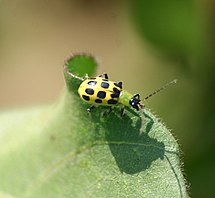While doing some weeding of the garden beds in preparation for my first spring plantings I came across some bugs (well grubs) of an unknown type. By the way, this is a great time to pull up any dandelions, dock and other taproot weeds since the soil is still very soft and moist; it's more likely you will get the entire root out rather than have it break off and re-sprout. The grubs I found were gray or dirty white with dark heads, I also found a green grub or caterpillar that was hanging around in the weeds. I have no idea what they are, after some internet investigations the best answer I could find was cutworms. Since I'm not certain of this I tossed them over the fence into the empty lot. If they are harmful at least they are out of the garden, if not, I wish them the best in their new home.
I am considering picking up some beneficial nematodes to help manage soil dwelling pests. One reason for this is that I spotted two cucumber beetles at the end of last summer, bright beautiful little green ladybug-like beetles with 12 black spots. While they are very pretty, these beetles are a real problem in the garden. They eat just about any vegetable they can get to, then lay eggs in the soil, when larva hatch they too will feast on vegetables and they spread bacterial wilt and squash mosaic virus.
 |
| Spotted cucumber beetle |
Cucumber beetles also have a striped species that looks similar but the spots are instead stripes that run from the head to the rear. These guys are a real danger to a garden. Unfortunately they are also a challenge to be rid of. Parasitic wasps can be helpful, if you don't know how to get these, try planting flowers that will attract them to the garden. Tiny nectar-filled flowers such as thyme, savory, dill, cilantro, parsley, yarrow, candytuft, verbena, sweet allysum and goldenrod. If you spot caterpillars or other pest bugs with tiny white sacs attached to them leave them alone! The sacs are the cocoons of parasitic wasps and the pests will die when they emerge, spawning a new generation of pest killers. Another cucumber beetle predator is the soldier bug, "leather"-backed firefly-like bugs that can eat up to 100 bugs a day. Soldier beetles are attracted to pollen and nectar filled flowers and particularly like hydrangea, goldenrod and milkweed. Tachinid flies are also effective at managing beetle populations, and are another type of parasitoid. Tachinids are not as preferential as other biological controls and will just as likely parasitize butterfly caterpillars. Having a large garden variety will help to attract these pest managers.
Beneficial nematodes are microscopic roundworms that live in soil and prey on soil dwelling insects. They are effective controls of fleas, ants, termites, roaches, flies, grubs; yet they are harmless to humans, pets, and our soil-dwelling friends the earthworms. You can try to attract nematodes to the garden by adding plenty of compost and having rich organic soil, but this is a grab bag; you could just as easily attract pest nematodes. It may be wiser to purchase a small package of beneficial nematodes to spread through your garden instead.
Since I live in a mobile home park that was built over an orchard in the 60s, I suspect this area was heavily treated with pesticides in the past and the likelihood of it supporting its own nematode population is fairly slim. So I will most likely purchase them from a supplier and sow them in and around my garden and yard. Ants are a major issue in our area, and I imagine if we had a natural nematode population that would not be the case.
No comments:
Post a Comment